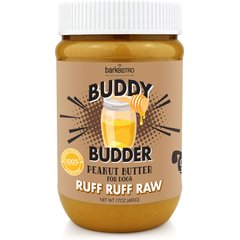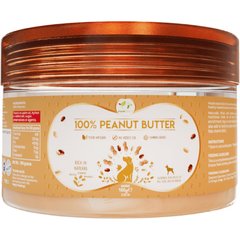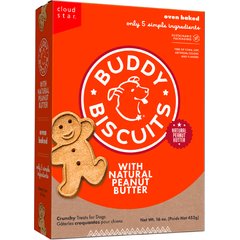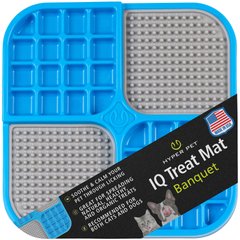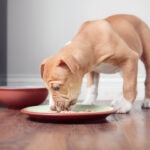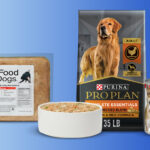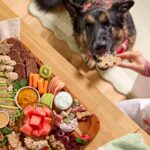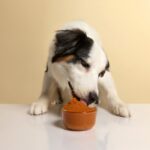Can Dogs Eat Peanut Butter?
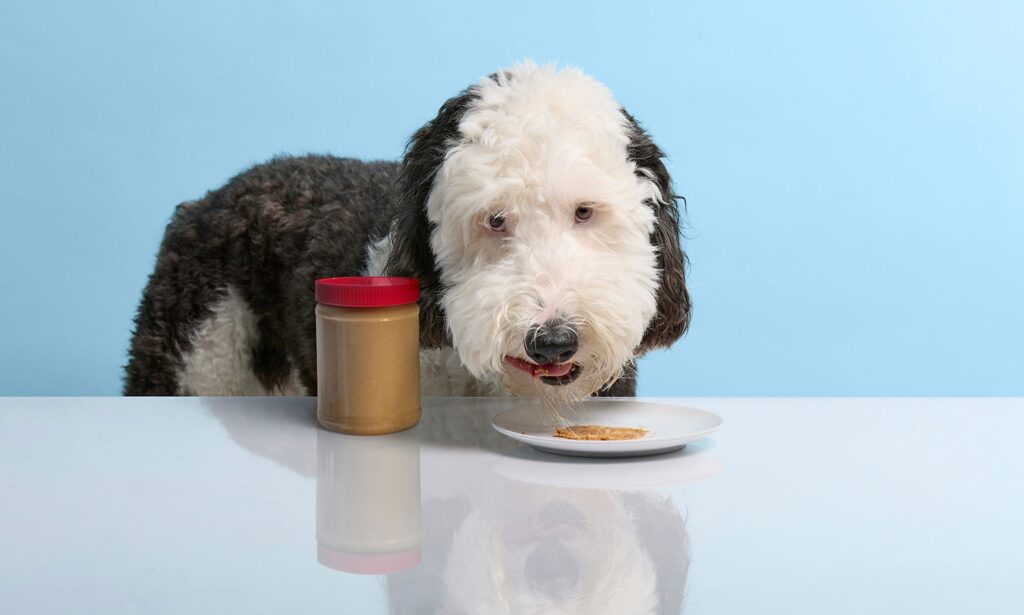
Photo by Chewy Studios
Few things light up a dog’s eyes like the sight—and smell—of peanut butter. Whether it’s spread on a lick mat or snuck off your spoon, this nutty spread is a favorite for pups everywhere. But can dogs eat peanut butter safely?
Yes, dogs can have peanut butter in moderation, but it’s essential to check the ingredients before you let your pup lick the jar clean. Here’s what you need to know about the benefits, the risks, and how to share peanut butter with your dog safely.
Before introducing any new food into your dog’s diet, always check with your veterinarian.
Key Takeaways
- Yes, dogs can eat peanut butter—as long as it’s xylitol-free and contains only simple ingredients like peanuts with no added sugar or artificial sweeteners.
- Peanut butter offers protein, healthy fats, and vitamins that support muscle development, energy, and coat health when fed in moderation.
- Avoid overfeeding. Peanut butter is calorie-dense and too much can cause stomach upset, weight gain, or even pancreatitis.
- Stick to the 10% treat rule: Peanut butter—and all treats combined—should make up no more than 10% of your dog’s daily calories.
Can Dogs Have Peanut Butter?
Yes, most dogs can have peanut butter as long as they’re given it in moderation and it doesn’t contain harmful ingredients, especially xylitol. This is a sugar substitute that’s highly toxic to dogs. You’ll also want to skip brands with added sugar, salt, or artificial flavors.
For the safest bet, choose an all-natural peanut butter made with just peanuts. To make things really simple, you can opt for peanut butter made specifically for dogs, like Bark Bistro Company Buddy Budder, or peanut butter-flavored dog treats. Some good options include:
Recommended Products
Is Peanut Butter Good for Dogs?
Peanut butter isn’t just tasty for your pup. It also offers some nutritional perks when fed in moderation, including:
- It provides a protein boost. Peanut butter packs a good amount of protein, which helps your dog build and maintain strong, healthy muscles.
- It contains healthy fats. The natural fats in peanut butter, like omega-6 fatty acids, give your pup an energy boost while also keeping their skin soft and coat shiny.
- It offers vitamins and minerals. Peanut butter isn’t just empty calories—it delivers vitamin B, vitamin E, magnesium, and niacin, all of which support your dog’s overall health.
Is Peanut Butter Bad for Dogs?
While peanut butter is safe in moderation, there are a few risks to consider when giving it to your pup:
- It’s relatively high in calories. Even a small scoop of peanut butter packs a lot of calories. If you’re not careful with portions, this can contribute to weight gain.
- Some brands contain xylitol. This artificial sweetener is highly toxic to dogs; even tiny amounts can be life-threatening. Always double-check the label to ensure the product is xylitol-free.
- Too much can cause stomach upset. The high fat content may cause stomach upset or diarrhea, or can even lead to pancreatitis if dogs overeat.
Can Dogs Be Allergic to Peanut Butter?
Yes, dogs can be allergic to peanut butter, though it isn’t super common. Food allergies affect only about 0.2% of dogs, and peanuts aren’t usually at the top of the list. Proteins like beef, chicken, eggs, and milk tend to cause more issues.
Still, peanut allergies do happen, and the signs can look a lot like other food sensitivities:
- Itching
- Skin redness
- Ear infections
- Hives
- Vomiting
- Diarrhea
- Swelling
- Difficulty breathing (in severe cases)
If you notice any of these symptoms after your dog eats peanut butter, stop giving it to them and contact your vet right away. If your dog is struggling to breathe, bring them to the emergency vet immediately.
How Much Peanut Butter Can a Dog Eat?
Like most treats, peanut butter should only be an occasional indulgence—not an everyday snack. Follow the 10% rule: No more than 10% of your dog’s daily calories should come from all treats combined. The rest should come from a well-balanced dog food.
If you’re introducing peanut butter, start with just a tiny lick to make sure your dog tolerates it well. And always keep an eye out for signs of stomach upset, like vomiting, diarrhea, or refusing other food.
Here’s a general guide for safe serving sizes:
| Dog Size | Serving Size | Frequency |
|---|---|---|
| Extra-small dogs (2–10 pounds) | 1/2 teaspoon | Once daily |
| Small dogs (11–20 pounds) | 1/2 teaspoon | Twice daily |
| Medium dogs (21–50 pounds) | 1 teaspoon | Once daily |
| Large dogs (51–90 pounds) | 1 teaspoon | Twice daily |
| Extra-large dogs (91+ pounds) | 1 tablespoon | Once daily |
How To Safely Feed Peanut Butter to Dogs
Before feeding peanut butter to your dog, remember to:
- Read the label carefully. Choose plain, unsalted peanut butter with no added sugar, xylitol, or artificial sweeteners.
- Keep portions small. Even if your dog begs for more, stick to the serving sizes above to avoid stomach upset and excess calories.
Once you’ve chosen a safe, xylitol-free peanut butter, the next step is to serve it in a way that’s both fun and engaging for your pup. Here are some ideas:
- Serve it straight up. Scoop a little peanut butter into your dog’s bowl and let them lick it up.
- Use it as an enrichment tool. Peanut butter is enrichment gold. Spread it on a lick mat, like the Hyper Pet IQ Treat Mat, or stuff it in a KONG toy for a simple way to keep your dog entertained and mentally engaged.
Recommended Products
- Mix it into homemade treats. Use peanut butter in homemade dog treats, like these no-bake peanut butter dog treats.
- Blend into a dog smoothie. Combine peanut butter with dog-safe fruits, such as bananas, and xylitol-free, sugar-free plain Greek yogurt, and blend until smooth. Use the mixture as a food topper or freeze it in a silicone tray for a refreshing treat.
My Dog Ate Too Much Peanut Butter—What Do I Do?
If your dog managed to sneak into the peanut butter jar, don’t panic—but do keep a close eye on them.
Too much peanut butter at once can cause some uncomfortable side effects, like:
- Vomiting
- Diarrhea
- Bloating
- Refusing to eat their regular food
Because peanut butter is high in fat, consuming large amounts may also increase the risk of pancreatitis in dogs, a condition that can become serious if left untreated.
If your pup only had a little extra, you can usually just monitor them at home and skip treats for the rest of the day. But if you notice persistent symptoms, call your vet for advice.
If your dog has eaten peanut butter containing xylitol, treat it as an emergency and take them to the vet right away. Xylitol toxicity can be life-threatening even in small amounts.
Can Dogs Eat Peanut Butter FAQs
Can puppies eat peanut butter?
Yes, puppies can have peanut butter in small amounts as long as it’s plain, xylitol-free, and given sparingly. Because their digestive systems are more sensitive, start with just a tiny lick and watch for any signs of stomach upset before making it a regular treat.
Can dogs have crunchy peanut butter?
Yes, dogs can have crunchy peanut butter. Follow the same rules as smooth peanut butter: It should be free of xylitol, sugar, salt, and other artificial ingredients.
What peanut butter has xylitol?
Peanut butter labeled “sugar-free” or “no sugar added” is more likely to contain xylitol, but always read the labels carefully. Even if you’ve been using a peanut butter for a long time, double-check the label each time you buy it, as manufacturers often change ingredients.
Can dogs eat peanut butter and jelly?
It’s best to skip the PB&J. Jelly is loaded with sugar or artificial sweeteners, and some varieties contain ingredients that are toxic to dogs, like grapes. Stick with plain peanut butter or peanut butter-based dog treats instead.
